Chinese Scholar's Garden
Snug Harbor Botanical Garden, Staten Island
Nature's mighty law is change.
- Robert Burns -
If Burns is right, then Chinese garden designers have executed a
clever, very long-drawn joke. For several thousand years they have
maintained a consistent view on gardens: Love nature but do not try
to master or change it.
So, Mr. Burns: In their constancy, have they been perpetrating
the unnatural?
These are the kinds of thoughts a visit to a Chinese Scholar's
garden might be expected to incite. Contemplation of Nature,
meditation and a communion with "the way", the standard directing
principle of the universe, is the purpose of such a garden. The
"conversation" with a poet across 200+ years is also appropriate,
since it is traditional to contemplate poetry inscribed on the
garden's walls and other surfaces, and respond by composing poetry
of your own.
Built, more than planted
Leave negativity behind
Plant symbolism
Making you look again
Slow down
Rockwork
Architecture
More Chinese gardens
A
Chinese garden is built, planting is less important.
Its key elements are stone, water, and architecture, followed by
plants and poetry.
When I walked through this garden I appreciated many of its
elements on several levels and felt I could study its details for
days and years. That makes it a very successful example of this
ancient design tradition, meant to honor contrasting natural forces
and bow to infinity by endlessly expanding a small space with
intriguing detail.
Look at it. I hope my pictures help you grasp these concepts, or
inspire you to go experience them yourself.
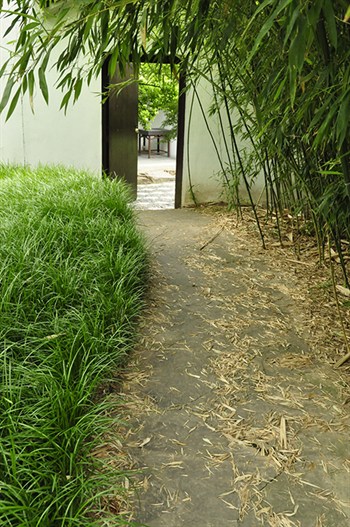
Leave
negativity behind you
Feng shui - literally, wind water, natural energies -- holds
that negative currents flow in straight lines. Thus there are
deflecting walls just inside entries and paths do not follow
straight lines. This disrupts and bars evil energy from the
garden.
See the curve in this path? Although it's not as markedly
non-straight as the zig zag bridge at the top of the page, it's
effective in achieving Feng Shui objectives.
Plant
symbolism
Plants are not as important as water and stone in the
traditional Chinese garden, but they are essential as markers of
seasonal rhythms and conveyances for symbolic messages.
- Mums can symbolize long life
- Peonies are a cure
- Banana is self improvement
- Delicate cherry blossoms on a stark, bare branch represent the
duel female-male forces, yin-yang
- Bamboo, versatile and able to bend without breaking, signifies
righteousness
- Pines speak of time
Given bamboo's traditional meaning, it is pleasing to walk
into the garden along a bamboo path.
Add pine/time and water plus rock as the yin-yang balance of
the universe, and the thoughtful viewer can go in many directions
in looking out along this line.

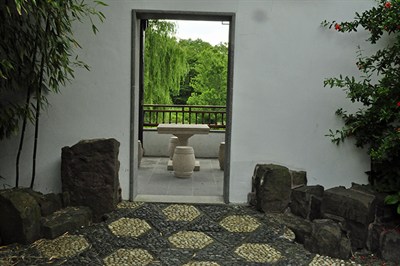
Look again, anew!
One of the designer's goals is to provide a visitor to the
garden with many views, and to present them in a way that's like a
scrolled painting being unrolled. So every door and "ling" or
"leaky window" deliberately frames a view.
This way of viewing a garden turns a single area into many
rooms.
(Click on small images to enjoy more detail.)

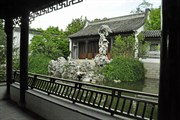

Slow down, you're moving
too fast 
Humpback bridges (click small images for more
detail) are one way to make a person pause and look down to check
his or her footing. The designer anticipates the visitor's pause,
and plans a changed view for that next step, the look up.
A change in paving is another device that
causes a person to look down, and provides a chance for the
designer to switch perspective. The change can be drastic -- a
natural slab breaks a tiled pattern -- or much more subtle. It may
be visual, tactile, or both. It may or may not be at an expected
point of change, such as at a doorway or as you step through the
round arch called a moon gate. Mosaic pattern walks are
deliberately bumpy so the walker reads by foot and glances down
when the feel is new. Can you see the change or imagine the feel of
the changes I caught in these pictures?
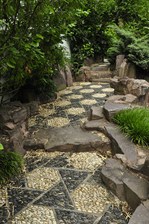

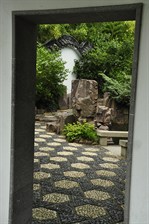
Scholar rocks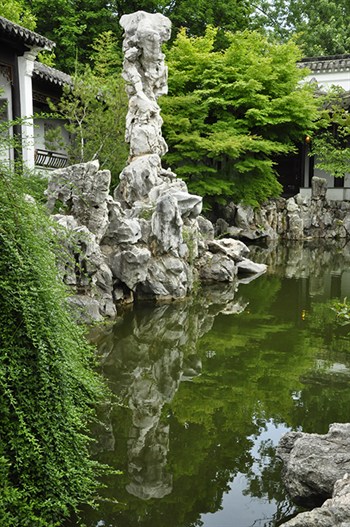
The curious, weathered stones here are Lake Tai stones, also
called Chinese Scholar's rocks or tax refund stones -- after an
emperor waived taxes for those who transported the stones for his
garden project.
As huge boulders or as pocket sized pebbles in the miniature
dish gardens called peng-jing, they've been integral parts of most
Chinese gardens for about six centuries, since the Ming
Dynasty.
They come from in and around an enormous lake in the Yangtze
Delta, a landform and rock type that may date back 70 million years
to a meteor impact. A stone's convoluted form is prized but carving
is frowned upon. However, it can be acceptable to choose a stone,
chisel a minor change, then put it back into the lake to be
naturally smoothed of all tooling marks before it's used by a great
grandchild.
Architecture
A Scholar's garden must have living quarters, library and study,
and perhaps a small reception area. Other, grander Chinese gardens
might have dozens of buildings for retired servants, poets in
residence, meeting rooms and visitors' quarters. The various
buildings are connected by covered walkways, meant to be used every
day of the year.
Decorative trim and railings, like mosaic paving patterns and
path routes, are many and distinctive. Consider: Plum blossoms on
cracked ice, playing cats. A pattern conveys meaning to the learned
gardener, and multiple elements combine to add nuance.
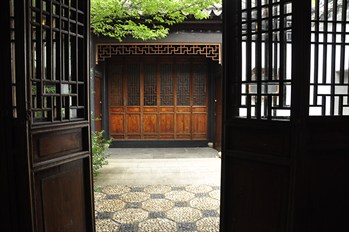
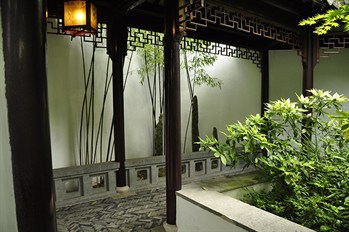
A building that extends over a lake represents infinity and
may be called a Xie (say Shi -eh).
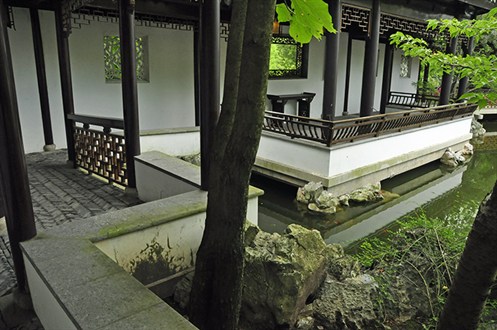
More Chinese gardens
This is one of only a few public gardens in the traditional
Chinese style in North America. We hope you will take time to see
it when you visit New York, or look for these elements in another
Chinese Garden near you. We have enjoyed:
We were glad to be able to see the beginnings of the Seattle
Chinese Garden
We have heard great reviews of:
If you know of others and send us a review, we'll add it to this
report so others can add them to their travel plans.